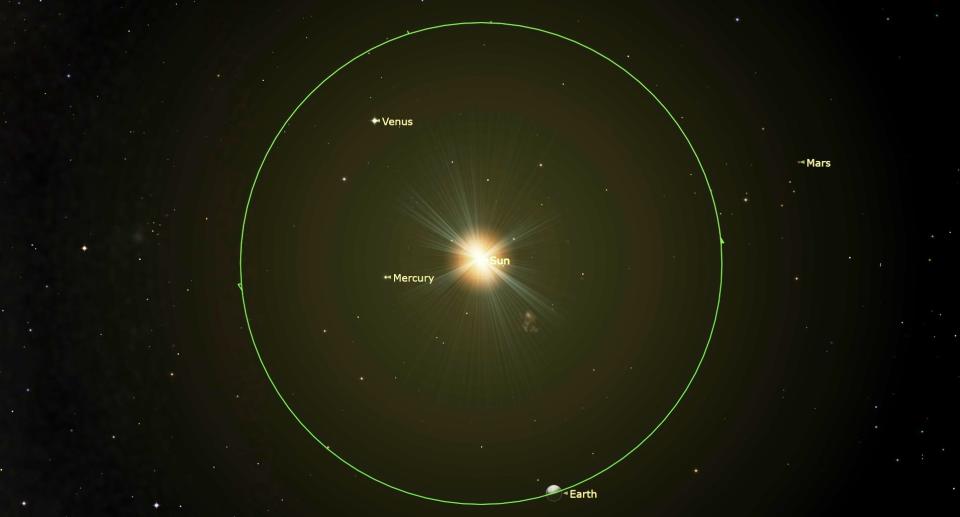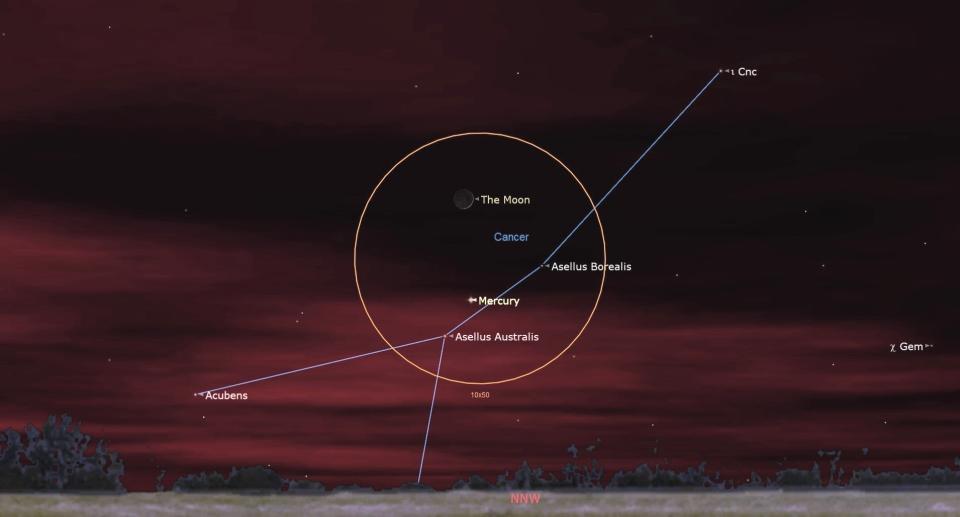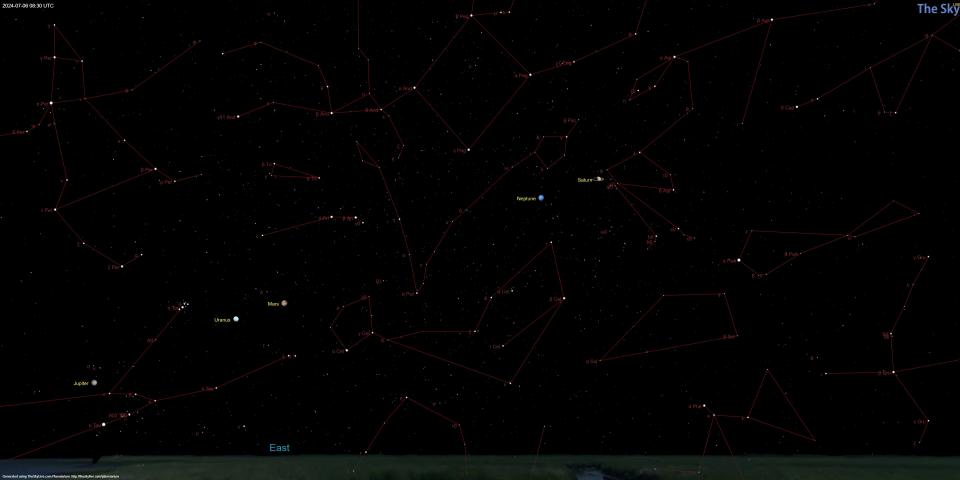The new moon in July 2024 will occur today, as the Earth reaches the point farthest from the Sun, the aphelion point.
The new moon will occur on July 5 at 6:57 p.m. Eastern Time (2257 UTC), according to the U.S. Naval Observatory, and two days later the young moon will pass close to Mercury in the evening sky.
Earth reached aphelion today, meaning we were farther from the Sun than at any other time in its annual orbit. Earth’s orbit around the Sun is slightly elliptical or oval-shaped, meaning our distance from our star can vary by up to 3% during the year. This small change is not significant enough to be noticeable to most observers.
New moons occur when the moon is directly between the sun and the Earth; they mark the beginning of the lunar month in many lunar calendar systems. Technically, the sun and moon are in conjunction, on the same north-south line through the celestial pole. The timing of the moon phases is measured by where the moon is relative to the Earth, so a given phase occurs at the same time everywhere in the world. Any differences are simply due to the time zone one is in – for example, the new moon in Melbourne, Australia occurs at 8:57 a.m. on July 6.
New moons are not visible unless they are eclipsed; eclipses do not occur at every new moon because the orbits of the Moon and Earth are not perfectly aligned; they are tilted about 5 degrees relative to each other. The Moon’s shadow then “misses” the Earth most of the time. (The next solar eclipse will not occur until October 2, 2024).

Close pass of Mercury
BEST TELESCOPE CHOICE:


Looking for a telescope to see the brighter planets of the solar system? We recommend the Celestron Astro Fi 102 as a top pick in our best beginner telescope guide.
In the evening hours of July 7, the Moon will pass by Mercury as it leaves its new phase; the thin crescent will be slightly 3 degrees north of Mercury at 14:33 Eastern timeAccording to the skywatching site In-the-Sky.org. At sunset, when the moon becomes visible, it will be about 16 degrees above the horizon; Mercury will be below the moon. But the planet won’t actually be visible at all until about 9 p.m. (sunset that day) approximately 8:29 pm. in New York; times are similar in cities like Chicago or Sacramento) and will be only 8 degrees high by then, so it will be difficult to see the conjunction from anywhere in the mid-northern latitudes – a flat, unobstructed, and clear horizon will be needed.
The conjunction becomes easier to observe as you get closer to the equator. From lower latitudes (north or south), the ecliptic, or the plane of Earth’s orbit projected into the sky, makes a steeper angle with the horizon. This means that planets moving within a few degrees of the ecliptic tend to reach higher altitudes. (This is why tropical sunsets appear very short, whereas sunsets at higher latitudes appear longer — in the tropics, the Sun approaches the horizon almost directly below, while in more northerly or southern latitudes, it approaches at a gentler angle.)
From Miami, the conjunction will occur at 2:33 p.m. local time, but both the Moon and Mercury will be higher in the sky; The sun sets at 20:16 local time, and at that point the moon is 20 degrees above the western horizon and Mercury is 18 degrees above the western horizon. Around 8:30 p.m. Mercury should become visible and still be about 12 degrees above, so it should be possible to catch it with an unobstructed clear horizon.
From Bridgetown, Barbados (and similar latitudes) the moon will appear to the right of Mercury and at sunset, at 19:29 local timeThe moon is exactly 18 degrees high in the west, still 14 degrees above the horizon at 7 p.m., as is Mercury, and both will be more visible from the continental U.S.
In the Western Hemisphere the conjunction itself occurs in the afternoon, during the daytime, but as one moves east the conjunction progresses into the evening. From Madrid, Spain, the observing difficulties are similar to those in New York (the two cities are at almost the same latitude), but the conjunction occurs at 20:33 local time.
Observing in the Southern Hemisphere is a bit easier – the days are shorter because it’s the southern winter. In Sao Paolo, the sun sets at 5:22 PM local time and the conjunction occurs at 3:33 PM, but it’s still during the day, with the moon at sunset at 18 degrees above the northwest and Mercury visible above and to the left of the moon. Mercury won’t be visible until about 6:00 PM and will still be about 12.5 degrees above. In Cape Town, where the conjunction occurs at 8:33 PM local time – Sunset at 17:51 and the Moon and Mercury set at 7:34 p.m.; about half an hour after sunset the pair will be at an altitude of about 13 degrees in the northwest.


Visible planets
Venus will appear in the evening sky, but will still be largely lost in the glare of the sun; although it will appear somewhat higher in the sky as it approaches the equator at sunset, it will not be higher than five or six degrees as the sky begins to darken.
Saturn is the first planet to rise at 11:40 PM in New York City on July 5. It will be quite prominent in the sky in the constellation Aquarius, a fainter star group than most. It will be about 41 degrees above the south-southeast horizon when the sky begins to brighten at approximately 4:30 to 5:00 AM (morning of July 6).
Mars will be visible in the early morning hours; it will rise later as the year progresses, and the planet will eventually disappear in the sun’s dawning light. On the night of the new moon (July 5-6) in mid-northern latitudes, the planet will rise at approximately 2:00 a.m. — in New York City, it will rise at 2:03 a.m. and in cities like Chicago (1:56 a.m. CDT), Denver (2:10 a.m. MDT), and Sacramento (2:18 a.m. PDT), Mars will be in the constellation Aires, and Aires will be easy to spot because it consists of fainter stars.
Jupiter rises after Mars at 3:07 a.m. EDT in New York. Jupiter is in Taurus and above and to the left of Aldebaran, the brightest star in that constellation. Aldebaran is noticeably more orange and bright, making it easier to spot the planet, which is white-yellow and emits a steady light.
This means that around 4:30 a.m. local time, at mid-northern latitudes, the three naked-eye planets farther from the Sun than Earth will form a line of sorts from the eastern horizon to the right, starting with Jupiter and ending with Saturn.
In the Southern Hemisphere, for example, in Melbourne, Australia (where the new moon occurs on July 6), all three planets will form a line, but this time up and to the left (when one is facing north). Saturn will also be higher in the sky. In Melbourne (and other mid-southern latitude locations), Saturn will rise at 10:22 PM AEST on July 6; when the planet crosses (crosses the north-south line in the sky) at 4:43 AM on July 7, it will be exactly 58 degrees above the northern horizon. Mars will rise at 3:22 AM AEST, and Jupiter will rise at 4:47 AM. Jupiter’s position in the sky will be reversed with respect to Aldebaran; Jupiter will appear below Aldebaran rather than above it (still visible to the left).


Summer stars
For Northern Hemisphere skywatchers, around 10 p.m. the Summer Triangle is high in the eastern sky; the “top” star is Vega, the brightest star in Lyra the Lyre, which is nearly at the zenith (about 70 degrees above the horizon). The other two stars in the Summer Triangle are Deneb and Altair, both to the east (left) of Vega; from a dark spot in the sky the Milky Way can be seen inside the Triangle. The three stars form a roughly right triangle, with Altair at the southern end.
If you turn left – due north, you will see the Big Dipper on the left (west) and the pole star Polaris a little further down. If you follow the “pointers” (the two stars in front of Dipper’s bowl, Dubhe and Merak) to Polaris and continue straight ahead, you will come across the king Cepheus, and just below Cepheus is the “W” shape of Cassiopeia, which will be low in the northeast.
In the other direction, follow the Great Bear handle and “arc” to Arcturus, the brightest star in Boötes the shepherd, and continue down to Spica, the brightest star in Virgo. Turning south (left), you see the bright red star Antares, the heart of Scorpio, and in darker sky areas, looking up (north) from Scorpio, you see Ophiuchus the healer, Sagittarius, and the “teapot” shape to the left of Scorpio.
RELATED STORIES:
— What is the moon phase today? Moon phases 2024
— 2024 New Moon Calendar: When is the next new moon?
— The Moon: Everything you need to know about Earth’s companion
In mid-southern latitudes, the winter stars are seen – darkness comes earlier. At 7:00 p.m. the sky is dark and the Southern Cross is well above the southern horizon, about 65 degrees. To the left (east) of the Cross is our nearest stellar neighbor, Alpha Centauri, also called Rigil Kentaurus. Further east and closer to the horizon is Scorpius, but inverted (from a northern hemisphere observer’s perspective) and very high in the sky; Antares is exactly 47 degrees above the horizon at 7:00 p.m.
To the southwest, the ship’s keel, Puppis, sinks and is marked by Canopus, about 20 degrees above the southwestern horizon. Canopus is the second brightest star in the night sky, after Sirius. To the left (south) in the same region of sky are the Large Magellanic Cloud and the Small Magellanic Cloud, two satellite galaxies of the Milky Way.